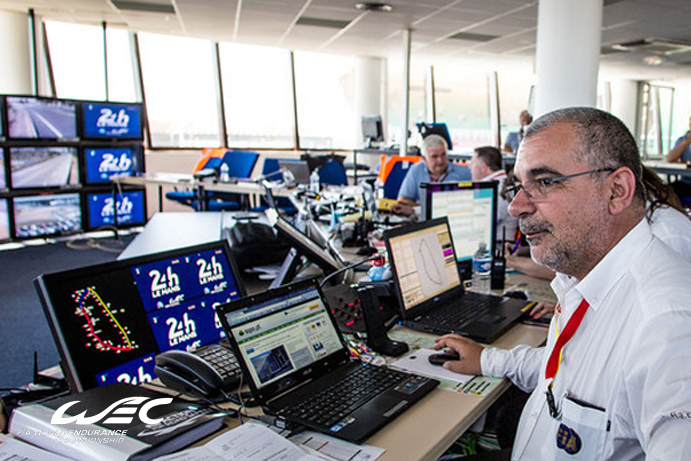

So how do Race Director Eduardo Freitas and his team follow the action? What facilities and equipment do they use to keep their fingers on the pulse of the race? In the second part of this interview, we take a closer look at some of the facilities and innovations being used.
“We get details about what happens on track through CCTV and TV images which have both improved a lot in the last few years,” acknowledges Eduardo. “We are also, from this season, using the new in-car marshalling system which brings us into a new world as far as race management is concerned. It allows us to understand a bit better what happens on track when we put marshalling together with timing. New tools are being brought in all the time so we can enforce the rules of the game in a more clever, efficient and accurate way.”

In front of the team, at the majority of tracks used, is a huge bank of screens covering every single area and aspect of the circuit, and both Eduardo and Lisa will each use 10 specific screens during the course of a session, 8 on the big display plus a computer and video facilities on a specific control desk. There are the people who take care of communicating individually with each marshal and operation of the CCTV and, where this is installed, the video footage is used for analysis and for use by the Stewards in the case of any disputes or penalties.
Since the introduction of an ‘intranet’ system which links Race Control to each of the teams on the pit wall (the Race Control Notification System or RCNS), team managers and engineers have not had to make quite so many trips up and down the pit lane to ask questions or to query decisions. The RCNS is dedicated to each team, and each email is only sent to one individual. The exception is when a team manager or driver is called to ‘The Headmaster’s Office’ for an explanation or an incident or to receive a reprimand for bad behaviour on track!

The Race Director also has direct access to Timing/Scoring plus, as Eduardo explains, “a dedicated frequency giving me access to the pit wall, which is what people sometimes hear at home on the TV.
“This frequency will override many of the radio signals we have in the pit lane, which is why it’s only used for major, urgent information. I can also communicate with the teams via their timing monitors or the marshalling system which is where Lisa comes in – she is the one who puts up the messages you see on monitors at a track, and who runs the RCNS. Now we also have the ability to send messages to the drivers in their cars, which is something we are developing and something which won’t be used a lot. It requires attention from the drivers and, when you’re running at 300kph, I would prefer their concentration to be directed more to the track than to what kind of messages I might be sending. It’s a new tool for this year and we’ll see basically how useful it is and how we can deal with it both from our side and from the driver’s.”
If our Race Director was to be asked to name his ideal race, the answer would be easy. “The one where there are no interventions, and where the drivers are taking care of everything by themselves without giving me any kind of work!”
Conversely, there are races such as the 6 Hours of Fuji last year where the torrential rain and subsequent track conditions presented Race Control with a ‘worst-case scenario’ which ultimately led to the race being suspended twice and then red-flagged after only 16 racing laps. “We had 293 RCNS messages in the space of 4 hours, and Lisa never left her seat at any point,” reflected Eduardo. “This was on top of dealing with all the radio messages and people coming into Race Control to ask questions. It was stressful at the time but, strangely enough, that’s where you learn where the flaws are in the system and that’s how we change and evolve and introduce new regulations for the following season.”
Decisions such as Safety Car interventions for bad weather are not taken lightly and the opinions of drivers from all four classes are sought by Race Control because different types of cars handle different conditions differently. A broad range of feedback is asked for, and always given, and the Race Director acknowledges that it is a great help. “They are the end users, in the car, and no matter how good the CCTV, on board marshalling or camera systems are, or reports from marshals, the most important thing is to know how a driver feels inside the car.

“When you have several drivers from different classes saying that track conditions, for example, are getting beyond the borders of acceptable, what do you do? Do you risk someone getting hurt at the end of the day? The safety of everyone is paramount, and we will never take unnecessary risks.”
Race Directors – like football referees – often come in for a fair amount of criticism because it’s impossible to please all the people all the time and, sometimes, races are won or lost through decisions handed out in Race Control. Eduardo Freitas is, however, universally respected by the teams and drivers within the FIA WEC…we are in safe hands, and long may it continue!
Fiona Miller
Photos: CIRCUIT DES 24 HEURES (LE MANS, SARTHE, FRANCE), 24 HOURS OF LE MANS 2014 (1, 2 3), 11-15 JUNE 2014, RACE CONTROL; 24 HOURS OF LE MANS 2013 (5); 6 HOURS OF FUJI 2013, FUJI INTERNATIONAL SPEEDWAY, JAPAN (4). 1) Eduardo Freitas at his desk in Race Control; 2) Some of the screens available to the Race Director and his team; 3) 24 Hours of Le Mans Clerk of the Course Daniel Poissenot (left) conferring with Eduardo Freitas and Lisa Crampton; 4) Because of the weather conditions, the Safety Car was deployed by the Race Director; 5) The track marshals take direction from the Clerk of the Course who sits alongside the Race Director.